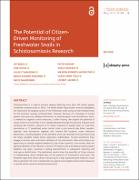| dc.contributor.author | Brees, Jef | |
| dc.contributor.author | Huyse, Tine | |
| dc.contributor.author | Tumusiime, Julius | |
| dc.contributor.author | Kagoro-Rugunda, Grace | |
| dc.contributor.author | Namirembe, Daisy | |
| dc.contributor.author | Mugabi, Faith | |
| dc.contributor.author | Nyakato, Viola | |
| dc.contributor.author | Anyolitho, Maxson Kenneth | |
| dc.contributor.author | Tolo, Casim Umba | |
| dc.contributor.author | Jacobs, Liesbet | |
| dc.date.accessioned | 2021-07-25T08:08:59Z | |
| dc.date.available | 2021-07-25T08:08:59Z | |
| dc.date.issued | 2021 | |
| dc.identifier.citation | Brees, J., Huyse, T., Tumusiime, J., Kagoro-Rugunda, G., Namirembe, D., Mugabi, F., ... & Jacobs, L. (2021). The Potential of Citizen-Driven Monitoring of Freshwater Snails in Schistosomiasis Research. Citizen Science: Theory and Practice, 6(1). | en_US |
| dc.identifier.uri | https://hdl.handle.net/123456789/290 | |
| dc.description.abstract | Schistosomiasis is a tropical parasitic disease affecting more than 200 million people
worldwide, predominantly in Africa. The World Health Organization recently highlighted
the importance of targeted control of the freshwater snails acting as intermediate hosts
for the parasites causing schistosomiasis. However, because of a shortage of trained
experts and resources, detailed information on spatiotemporal snail distributions, which
is needed for targeted control measures, is often missing. We explore the potential of
citizen science to build these much-needed datasets through fine-grained, frequent snail
sampling. We trained a network of 25 citizen scientists to weekly report on snail host
abundances in 77 predefined water contact sites in and around Lake Albert (western
Uganda). Snail abundance, together with marked GPS locations, water chemistry
parameters, and photographs of the identified snails are recorded and submitted using
the freely available mobile phone application KoBoToolbox. Trained researchers then
engage in remote, semi-automatic validation of the submissions, after which there is an
opportunity to provide targeted feedback to the citizen scientists. Five months after the
operationalisation of the network, a total of 570 reports were submitted and personalized
feedback was given, resulting in lasting improvements in subsequent reporting and
snail genus identification. The preliminary results show the possibility of citizen science
to independently obtain reliable data on the presence of schistosome snail hosts. We
therefore argue that citizen-driven monitoring on a high spatiotemporal resolution could
help to generate the much-needed data to support local targeted snail control measures
in remote and/or resource-limited environments. | en_US |
| dc.language.iso | en | en_US |
| dc.publisher | Citizen Science: Theory and Practice | en_US |
| dc.subject | schistosomiasis | en_US |
| dc.subject | snail hosts | en_US |
| dc.subject | Biomphalaria | en_US |
| dc.subject | Bulinus | en_US |
| dc.subject | Lake Albert | en_US |
| dc.subject | citizen science training | en_US |
| dc.subject | feedback | en_US |
| dc.subject | data quality | en_US |
| dc.title | The Potential of Citizen- Driven Monitoring of Freshwater Snails in Schistosomiasis Research | en_US |
| dc.type | Article | en_US |

